Abstract
OBJECTIVES: Because clinical clerkship grades are associated with resident selection and performance and are largely based on residents'/attendings' subjective ratings, it is important to identify variables associated with clinical clerkship grades. METHODS: U.S. medical students who completed > or =1 of the following required clinical clerkships--internal medicine, surgery, obstetrics/gynecology, pediatrics, neurology and psychiatry--were invited to participate in an anonymous online survey, which inquired about demographics, degree program, perceived quality of clerkship experiences, assertiveness, reticence and clerkship grades. RESULTS: A total of 2395 medical students (55% women; 57% whites) from 105 schools responded. Multivariable logistic regression models identified factors independently associated with receiving lower clerkship grades (high pass/pass or B/C) compared with the highest grade (honors or A). Students reporting higher quality of clerkship experiences were less likely to report lower grades in all clerkships. Older students more likely reported lower grades in internal medicine (P = 0.02) and neurology (P < 0.001). Underrepresented minorities more likely reported lower grades in all clerkships (P < 0.001); Asians more likely reported lower grades in obstetrics/gynecology (P = 0.007), pediatrics (P = 0.01) and neurology (P = 0.01). Men more likely reported lower grades in obstetrics/gynecology (P < 0.001) and psychiatry (P = 0.004). Students reporting greater reticence more likely reported lower grades in internal medicine (P = 0.02), pediatrics (P = 0.02) and psychiatry (P < 0.05). Students reporting greater assertiveness less likely reported lower grades in all clerkships (P < 0.03) except IM. CONCLUSIONS: The independent associations between lower clerkship grades and nonwhite race, male gender, older age, lower quality of clerkship experiences, and being less assertive and more reticent are concerning and merit further investigation.
Full text
PDF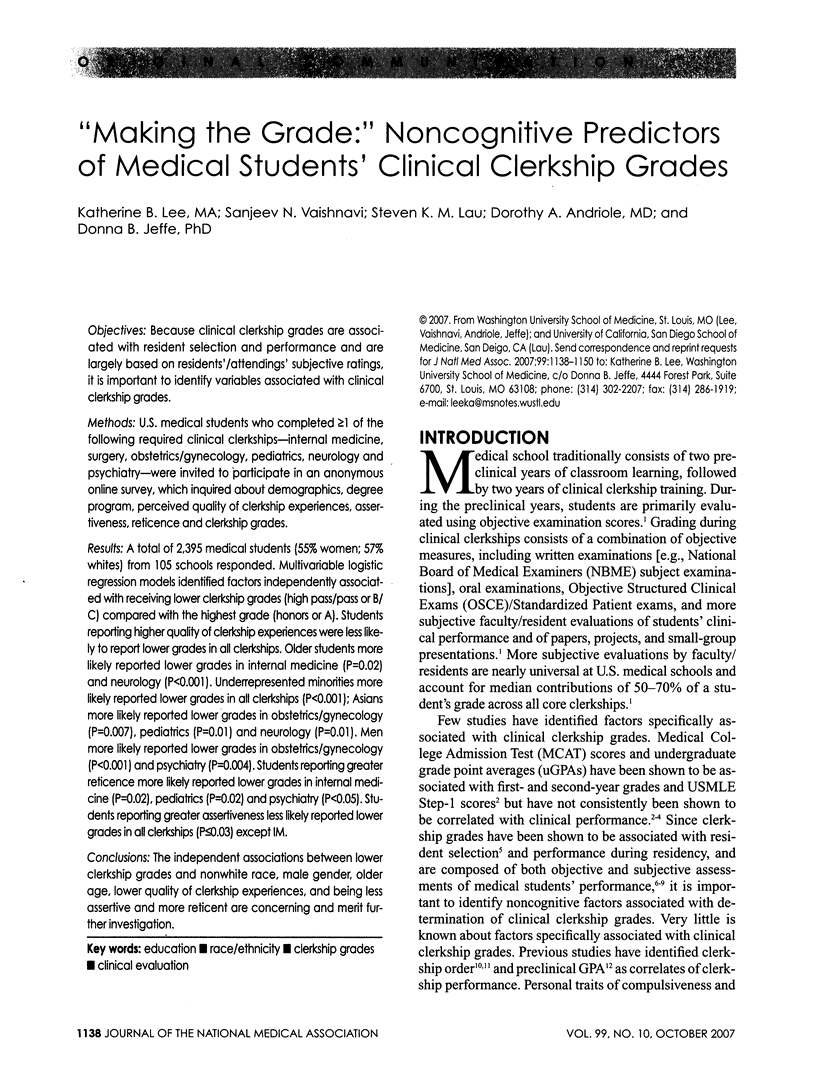
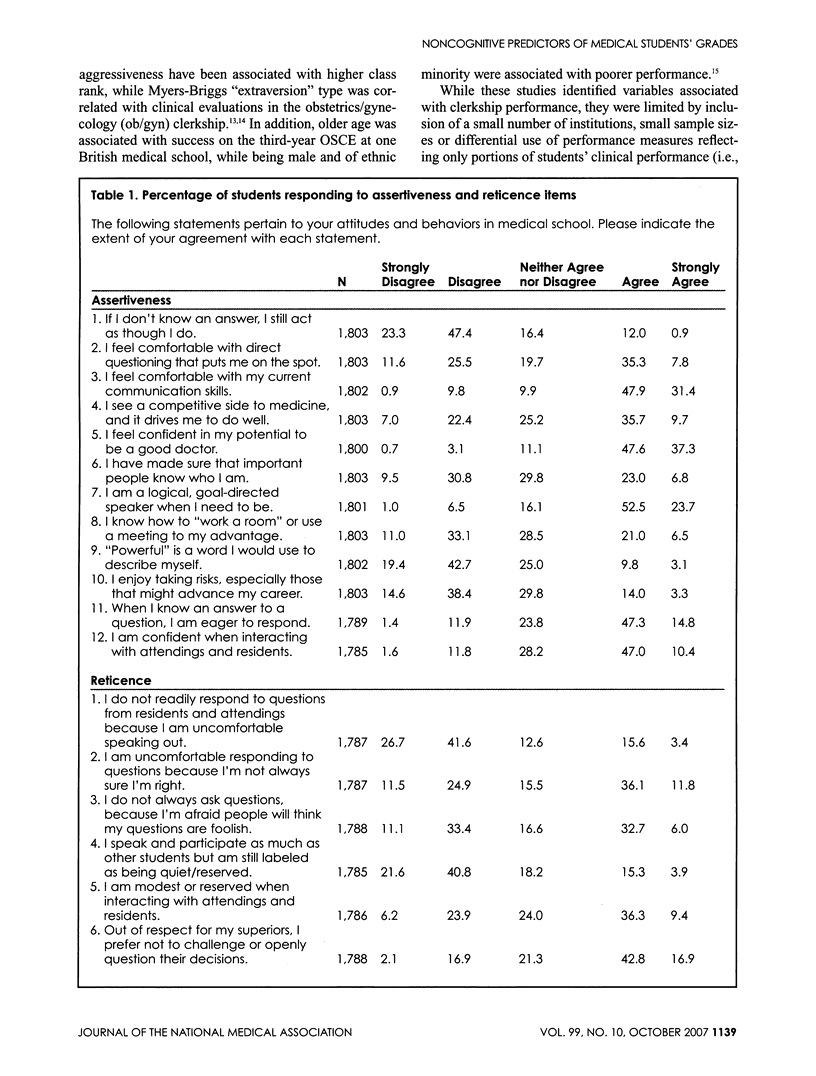
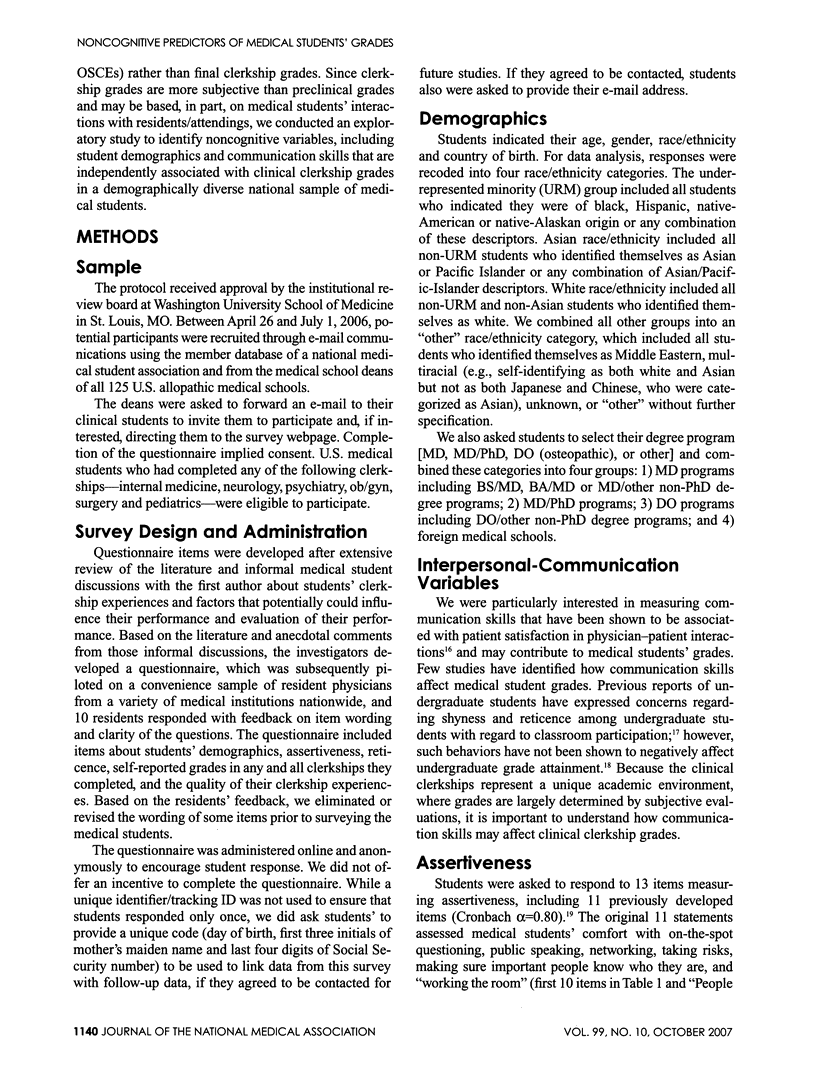
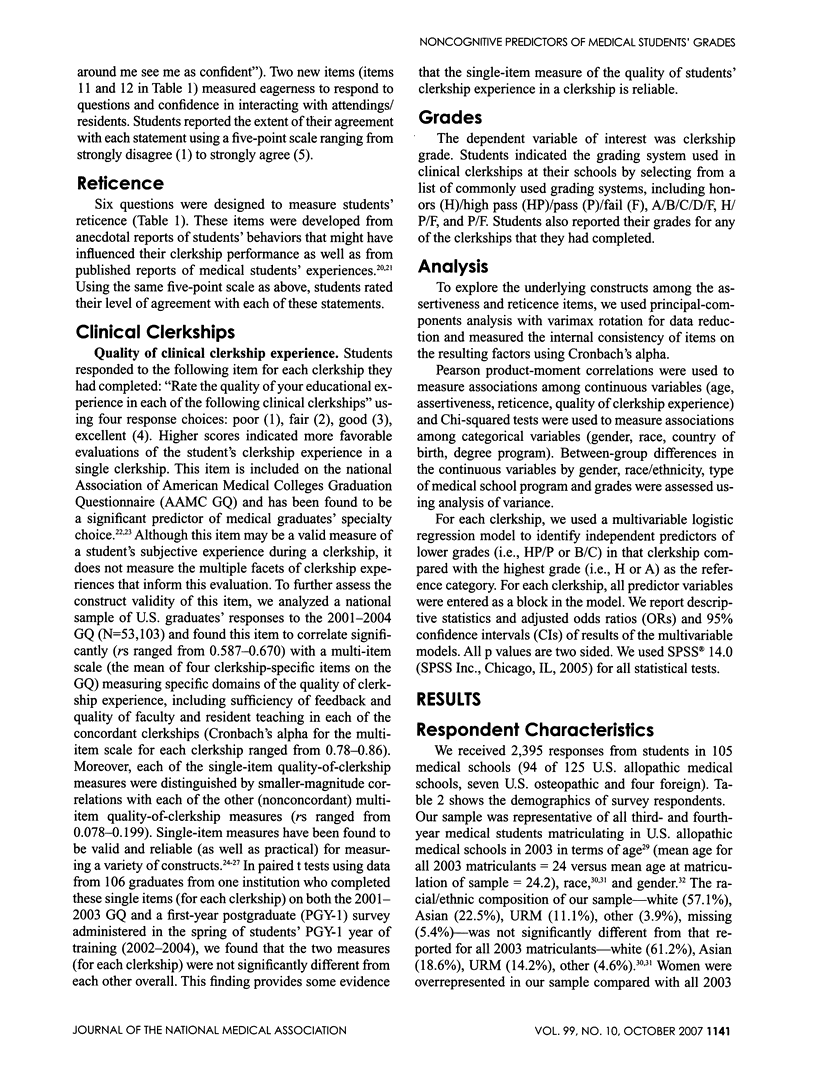
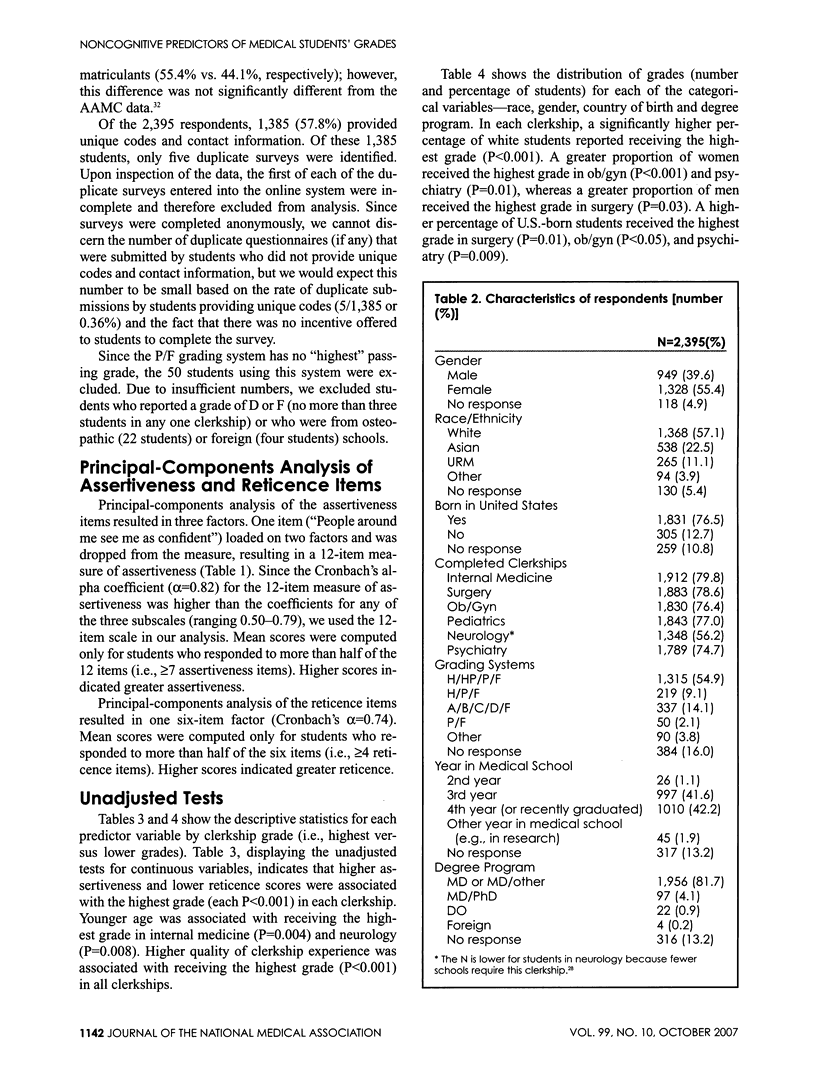
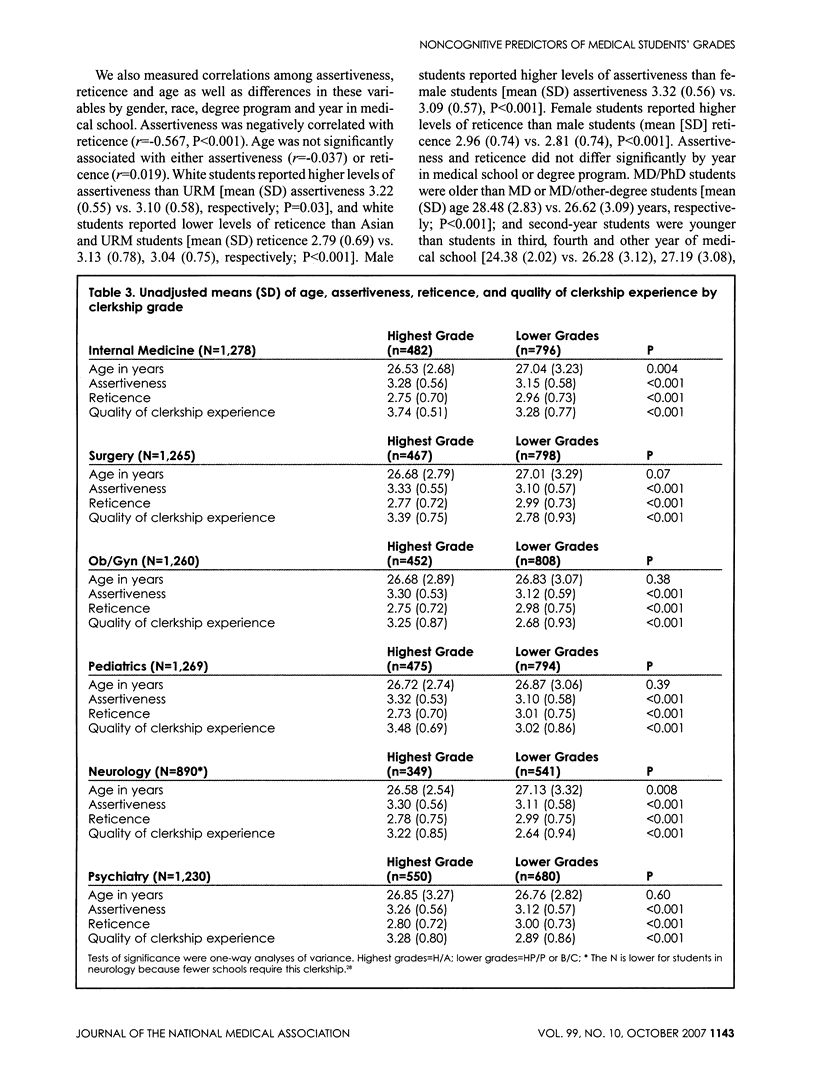
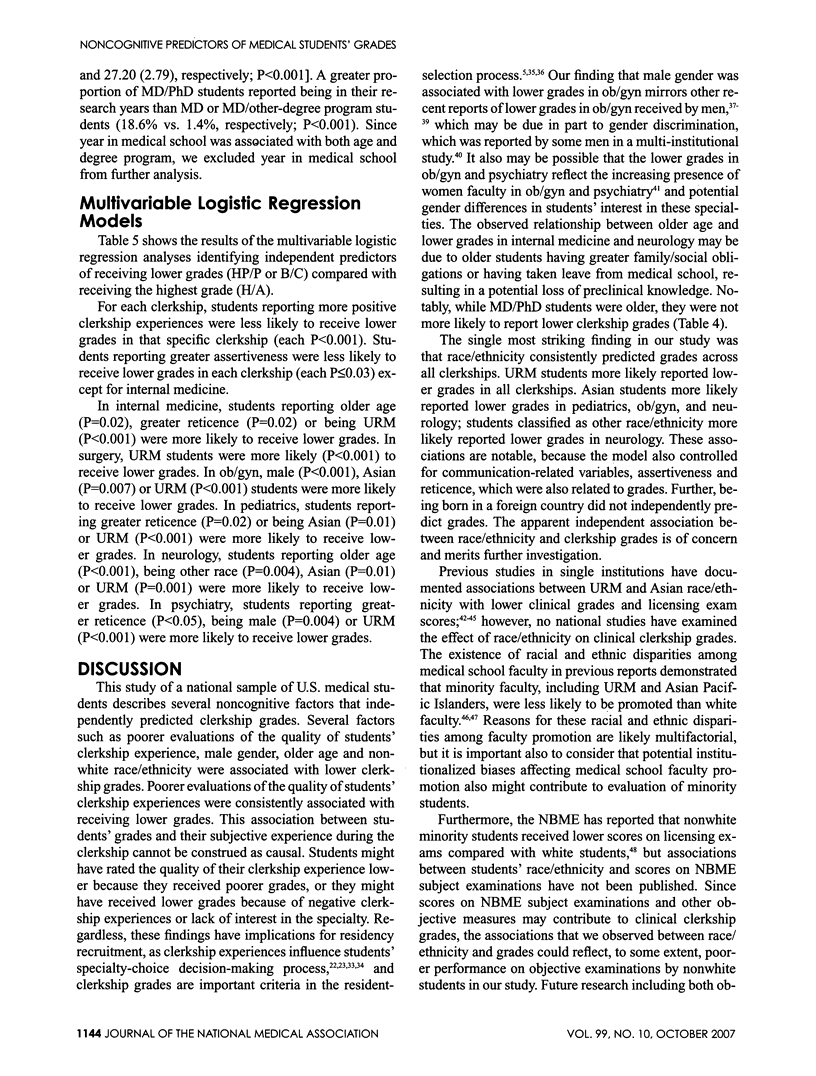
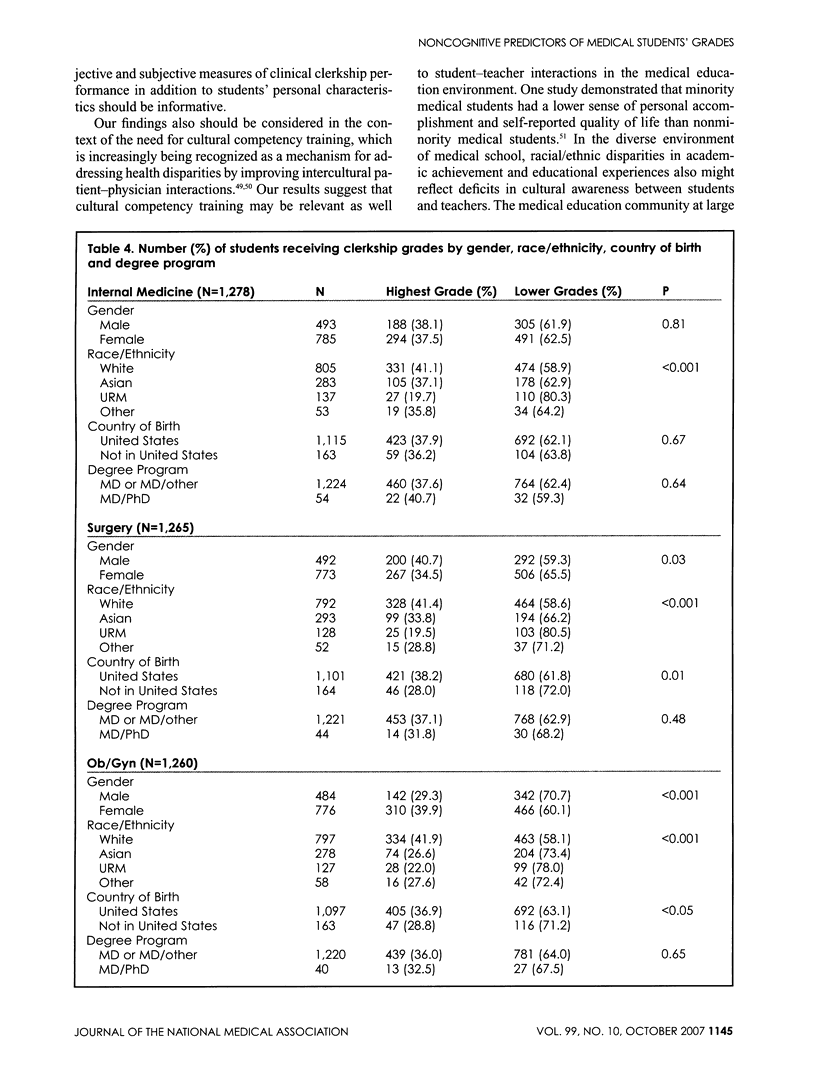

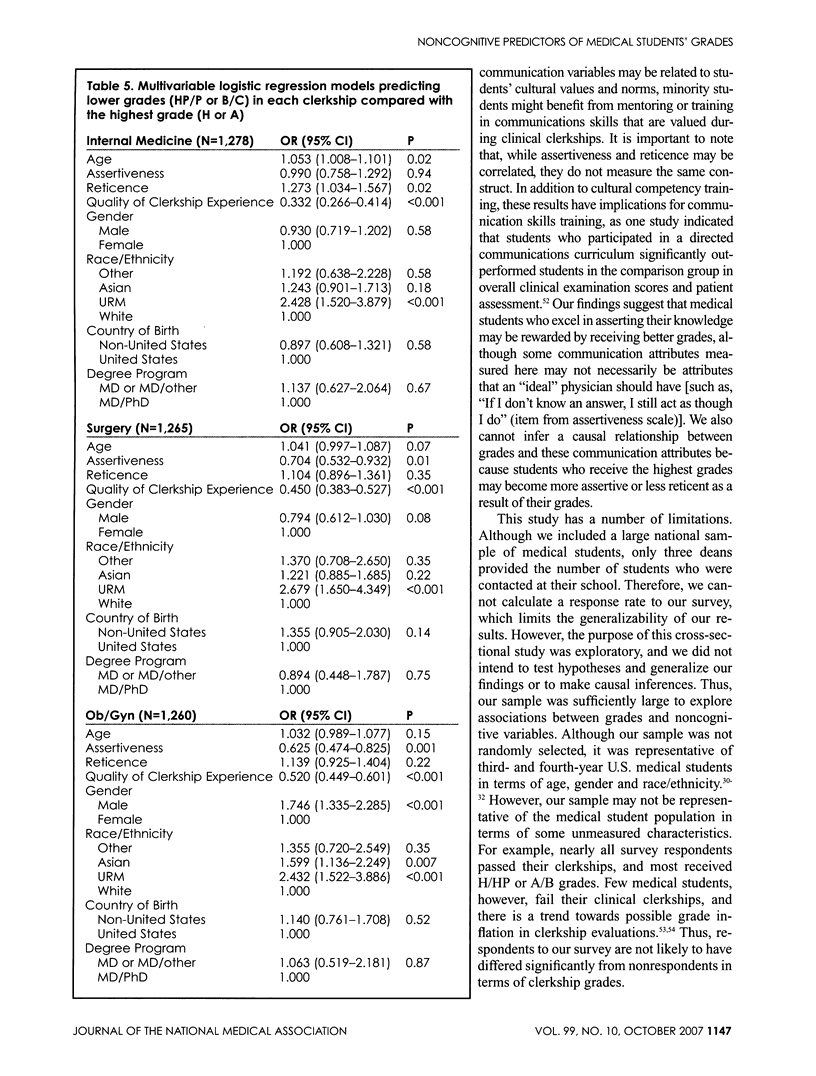
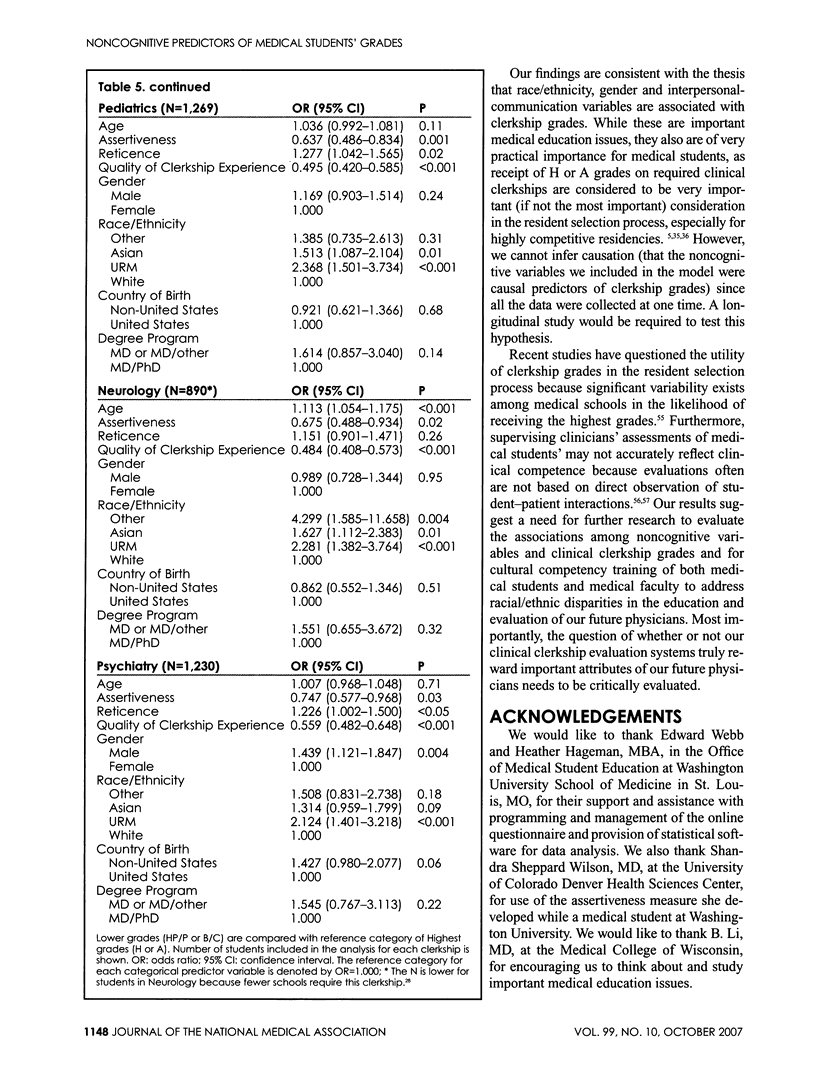
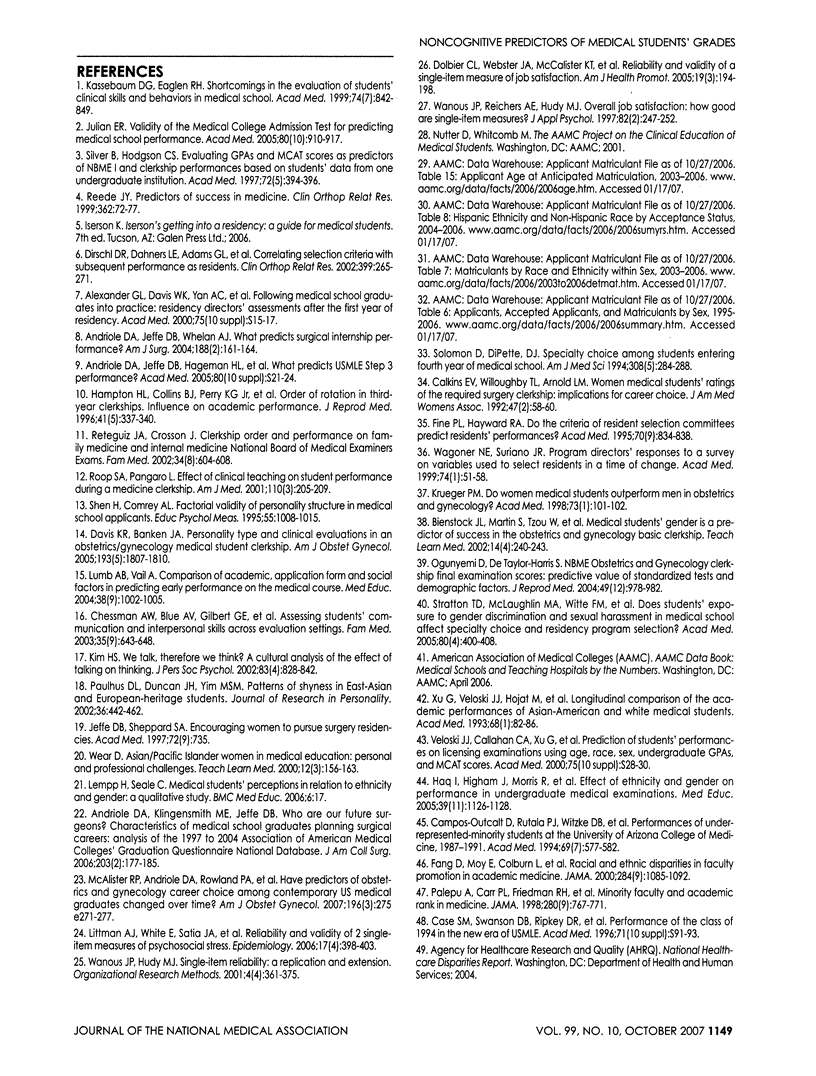
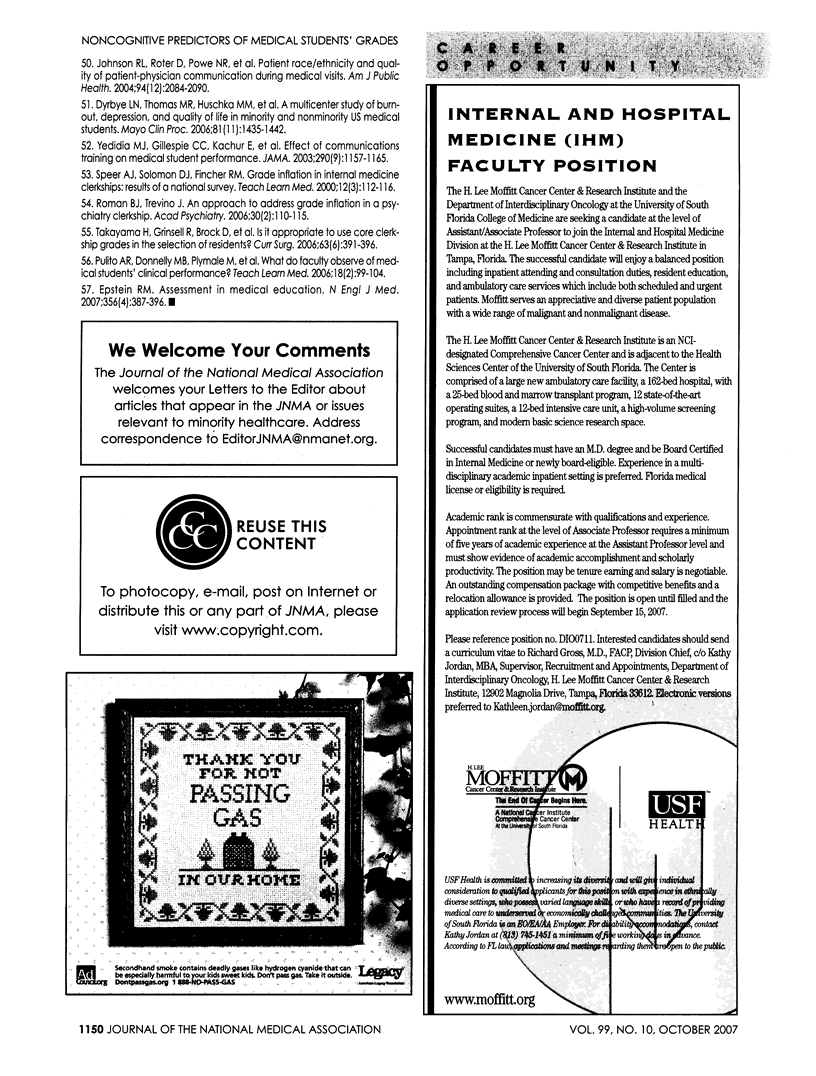
Selected References
These references are in PubMed. This may not be the complete list of references from this article.
- Andriole Dorothy A., Jeffe Donna B., Hageman Heather L., Whelan Alison J. What predicts USMLE Step 3 performance? Acad Med. 2005 Oct;80(10 Suppl):S21–S24. doi: 10.1097/00001888-200510001-00009. [DOI] [PubMed] [Google Scholar]
- Andriole Dorothy A., Jeffe Donna B., Whelan Alison J. What predicts surgical internship performance? Am J Surg. 2004 Aug;188(2):161–164. doi: 10.1016/j.amjsurg.2004.03.003. [DOI] [PubMed] [Google Scholar]
- Bienstock Jessica L., Martin Shari, Tzou Wendy, Fox Harold E. Medical students' gender is a predictor of success in the obstetrics and gynecology basic clerkship. Teach Learn Med. 2002 Fall;14(4):240–243. doi: 10.1207/S15328015TLM1404_7. [DOI] [PubMed] [Google Scholar]
- Calkins E. V., Willoughby T. L., Arnold L. M. Women medical students' ratings of the required surgery clerkship: implications for career choice. J Am Med Womens Assoc. 1992 Mar-Apr;47(2):58–60. [PubMed] [Google Scholar]
- Campos-Outcalt D., Rutala P. J., Witzke D. B., Fulginiti J. V. Performances of underrepresented-minority students at the University of Arizona College of Medicine, 1987-1991. Acad Med. 1994 Jul;69(7):577–582. doi: 10.1097/00001888-199407000-00015. [DOI] [PubMed] [Google Scholar]
- Chessman Alexander W., Blue Amy V., Gilbert Gregory E., Carey Maura, Mainous Arch G., 3rd Assessing students' communication and interpersonal skills across evaluation settings. Fam Med. 2003 Oct;35(9):643–648. [PubMed] [Google Scholar]
- Davis Katrina R., Banken Joseph A. Personality type and clinical evaluations in an obstetrics/gynecology medical student clerkship. Am J Obstet Gynecol. 2005 Nov;193(5):1807–1810. doi: 10.1016/j.ajog.2005.07.082. [DOI] [PubMed] [Google Scholar]
- Dolbier Christyn L., Webster Judith A., McCalister Katherine T., Mallon Mark W., Steinhardt Mary A. Reliability and validity of a single-item measure of job satisfaction. Am J Health Promot. 2005 Jan-Feb;19(3):194–198. doi: 10.4278/0890-1171-19.3.194. [DOI] [PubMed] [Google Scholar]
- Dyrbye Liselotte N., Thomas Matthew R., Huschka Mashele M., Lawson Karen L., Novotny Paul J., Sloan Jeff A., Shanafelt Tait D. A multicenter study of burnout, depression, and quality of life in minority and nonminority US medical students. Mayo Clin Proc. 2006 Nov;81(11):1435–1442. doi: 10.4065/81.11.1435. [DOI] [PubMed] [Google Scholar]
- Epstein Ronald M. Assessment in medical education. N Engl J Med. 2007 Jan 25;356(4):387–396. doi: 10.1056/NEJMra054784. [DOI] [PubMed] [Google Scholar]
- Fine P. L., Hayward R. A. Do the criteria of resident selection committees predict residents' performances? Acad Med. 1995 Sep;70(9):834–838. [PubMed] [Google Scholar]
- Hampton H. L., Collins B. J., Perry K. G., Jr, Meydrech E. F., Wiser W. L., Morrison J. C. Order of rotation in third-year clerkships. Influence on academic performance. J Reprod Med. 1996 May;41(5):337–340. [PubMed] [Google Scholar]
- Jeffe D. B., Sheppard S. A. Encouraging women to pursue surgery residencies. Acad Med. 1997 Sep;72(9):735–735. doi: 10.1097/00001888-199709000-00003. [DOI] [PubMed] [Google Scholar]
- Johnson Rachel L., Roter Debra, Powe Neil R., Cooper Lisa A. Patient race/ethnicity and quality of patient-physician communication during medical visits. Am J Public Health. 2004 Dec;94(12):2084–2090. doi: 10.2105/ajph.94.12.2084. [DOI] [PMC free article] [PubMed] [Google Scholar]
- Kassebaum D. G., Eaglen R. H. Shortcomings in the evaluation of students' clinical skills and behaviors in medical school. Acad Med. 1999 Jul;74(7):842–849. doi: 10.1097/00001888-199907000-00020. [DOI] [PubMed] [Google Scholar]
- Kim Heejung S. We talk, therefore we think? A cultural analysis of the effect of talking on thinking. J Pers Soc Psychol. 2002 Oct;83(4):828–842. doi: 10.1037//0022-3514.83.4.828. [DOI] [PubMed] [Google Scholar]
- Krueger P. M. Do women medical students outperform men in obstetrics and gynecology? Acad Med. 1998 Jan;73(1):101–102. doi: 10.1097/00001888-199801000-00021. [DOI] [PubMed] [Google Scholar]
- Lempp Heidi, Seale Clive. Medical students' perceptions in relation to ethnicity and gender: a qualitative study. BMC Med Educ. 2006 Mar 8;6:17–17. doi: 10.1186/1472-6920-6-17. [DOI] [PMC free article] [PubMed] [Google Scholar]
- Littman Alyson J., White Emily, Satia Jessie A., Bowen Deborah J., Kristal Alan R. Reliability and validity of 2 single-item measures of psychosocial stress. Epidemiology. 2006 Jul;17(4):398–403. doi: 10.1097/01.ede.0000219721.89552.51. [DOI] [PubMed] [Google Scholar]
- Louie Alan K., Coverdale John, Roberts Laura Weiss. Emotional intelligence and psychiatric training. Acad Psychiatry. 2006 Jan-Feb;30(1):1–3. doi: 10.1176/appi.ap.30.1.1. [DOI] [PubMed] [Google Scholar]
- McAlister Rebecca P., Andriole Dorothy A., Rowland Pamela A., Jeffe Donna B. Have predictors of obstetrics and gynecology career choice among contemporary US medical graduates changed over time? Am J Obstet Gynecol. 2007 Mar;196(3):275.e1–275.e7. doi: 10.1016/j.ajog.2006.12.028. [DOI] [PubMed] [Google Scholar]
- Ogunyemi Dotun, De Taylor-Harris Shawn. NBME Obstetrics and Gynecology clerkship final examination scores: predictive value of standardized tests and demographic factors. J Reprod Med. 2004 Dec;49(12):978–982. [PubMed] [Google Scholar]
- Pulito Andrew R., Donnelly Michael B., Plymale Margaret, Mentzer Robert M., Jr What do faculty observe of medical students' clinical performance? Teach Learn Med. 2006 Spring;18(2):99–104. doi: 10.1207/s15328015tlm1802_2. [DOI] [PubMed] [Google Scholar]
- Reteguiz Jo-Ann, Crosson Jesse. Clerkship order and performance on family medicine and internal medicine National Board of Medical Examiners Exams. Fam Med. 2002 Sep;34(8):604–608. [PubMed] [Google Scholar]
- Roop S. A., Pangaro L. Effect of clinical teaching on student performance during a medicine clerkship. Am J Med. 2001 Feb 15;110(3):205–209. doi: 10.1016/s0002-9343(00)00672-0. [DOI] [PubMed] [Google Scholar]
- Solomon D. J., DiPette D. J. Specialty choice among students entering the fourth year of medical school. Am J Med Sci. 1994 Nov;308(5):284–288. doi: 10.1097/00000441-199411000-00005. [DOI] [PubMed] [Google Scholar]
- Stalberg Peter, Sidhu Stan, Sywak Mark, Robinson Bruce, Wilkinson Margaret, Delbridge Leigh. Intraoperative parathyroid hormone measurement during minimally invasive parathyroidectomy: does it "value-add" to decision-making? J Am Coll Surg. 2006 May 30;203(1):1–6. doi: 10.1016/j.jamcollsurg.2006.03.022. [DOI] [PubMed] [Google Scholar]
- Stratton Terry D., McLaughlin Margaret A., Witte Florence M., Fosson Sue E., Nora Lois Margaret. Does students' exposure to gender discrimination and sexual harassment in medical school affect specialty choice and residency program selection? Acad Med. 2005 Apr;80(4):400–408. doi: 10.1097/00001888-200504000-00020. [DOI] [PubMed] [Google Scholar]
- Takayama Hiroo, Grinsell Rebecca, Brock Douglas, Foy Hugh, Pellegrini Carlos, Horvath Karen. Is it appropriate to use core clerkship grades in the selection of residents? Curr Surg. 2006 Nov–Dec;63(6):391–396. doi: 10.1016/j.cursur.2006.06.012. [DOI] [PubMed] [Google Scholar]
- Veloski J. J., Callahan C. A., Xu G., Hojat M., Nash D. B. Prediction of students' performances on licensing examinations using age, race, sex, undergraduate GPAs, and MCAT scores. Acad Med. 2000 Oct;75(10 Suppl):S28–S30. doi: 10.1097/00001888-200010001-00009. [DOI] [PubMed] [Google Scholar]
- Wanous J. P., Reichers A. E., Hudy M. J. Overall job satisfaction: how good are single-item measures? J Appl Psychol. 1997 Apr;82(2):247–252. doi: 10.1037/0021-9010.82.2.247. [DOI] [PubMed] [Google Scholar]
- Wear D. Asian/Pacific Islander women in medical education: personal and professional challenges. Teach Learn Med. 2000 Summer;12(3):156–163. doi: 10.1207/S15328015TLM1203_7. [DOI] [PubMed] [Google Scholar]
- Xu G., Veloski J. J., Hojat M., Gonnella J. S., Bacharach B. Longitudinal comparison of the academic performances of Asian-American and white medical students. Acad Med. 1993 Jan;68(1):82–86. doi: 10.1097/00001888-199301000-00013. [DOI] [PubMed] [Google Scholar]


